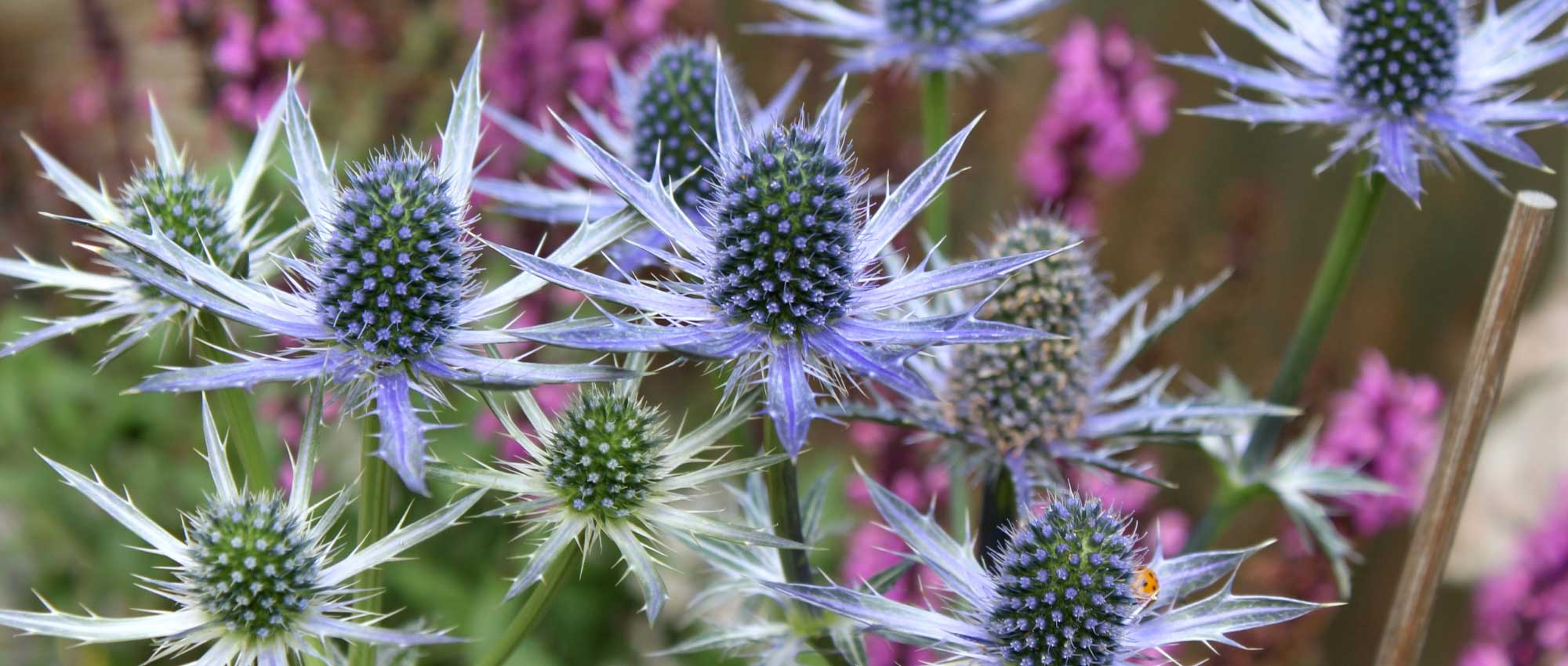
Eryngium, sea holly: planting, growing and care
Contents
Eryngium in a nutshell
- Eryngium is a plant with an incomparable graphic appearance that brings great originality to gardens
- Valued for its blue, silvery metallic tones
- A thistle that is very decorative in dried bouquets
- Easy to grow, it is undemanding and needs little maintenance
- Perfect for rock gardens but also well suited to naturalistic plantings, alpine gardens and coastal gardens
A word from our expert
With its metallic-blue or silvery hues, domed inflorescences and thorny foliage, Eryngium is a striking, original plant. Also called sea holly or blue eryngo, this plant bears heads surrounded by large bracts, carried on ramified, erect stems. It is prized for its uncommon colour, metallic blue or silvery white. Eryngium resembles a kind of ornamental thistle and is also reminiscent of Echinops!
There are many species of Eryngium, all very striking and decorative. Discover, for example, superb Alpine sea holly, Eryngium alpinum, which bears beneath its inflorescences large, finely cut, elegant bracts; as well as Eryngium planum, which produces numerous metallic-blue heads with a very natural appearance. Eryngium maritimum, meanwhile, is distinguished by silvery, leathery, very thorny leaves.
In addition to its original, modern look, Eryngium is fairly easy to grow. It tolerates drought, poor, stony soils and sea spray. It requires very little maintenance. Its main enemy is excess moisture: make sure to plant it in well-draining soil and, if possible, in full sun.
Description and botany
Botanical data
- Latin name Eryngium sp.
- Family Apiaceae
- Common name eryngo, sea holly
- Flowering between July and September-October
- Height between 15 cm and 1.50 m, or more
- Exposure full sun
- Soil type free-draining, rather poor, rocky
- Hardiness often between –15 and –25 °C
Eryngiums, also called Panicauts in French, are perennial plants or annuals, even biennials, comprising nearly 260 species. They are often spiny, show blue or silvery tones, and resemble thistles. They have a wide global distribution, although the greatest number of species is found in South America. Around twenty species occur in Europe, notably around the Mediterranean. In France, several species grow wild. They can be found in mountainous regions: Eryngium alpinum grows in Alps (commonly called “Alpine Panicaut” or “Alpine sea holly”), while Eryngium bourgatii occurs in Pyrenees. Eryngium campestre occurs across the country, while Eryngium maritimum is found on coasts (Atlantic and Mediterranean). In the wild, most Eryngium species grow in dry meadows or rocky places. However, South American species tend to occur on marshy, wet ground.
Most Eryngiums have hardiness between –15 and –25 °C. Species from mountainous regions such as Alps or Pyrenees are fully hardy and well adapted to harsh climates. Least hardy are species native to South America: Eryngium pandanifolium, Eryngium proteiflorum, Eryngium agavifolium…
They are valued in the garden for their originality, graphic form and metallic tones. Botanical species are fairly common in gardens, although horticultural varieties selected by breeders also exist.
Eryngiums belong to family Apiaceae (more than 3,200 species), previously called Umbelliferae. They are characterised by flowering often in umbels of white flowers and foliage usually deeply divided and aromatic. This is the case for carrots, parsnips, dill, chervil, fennel, but also Astrances, Orlaya and Angelica.
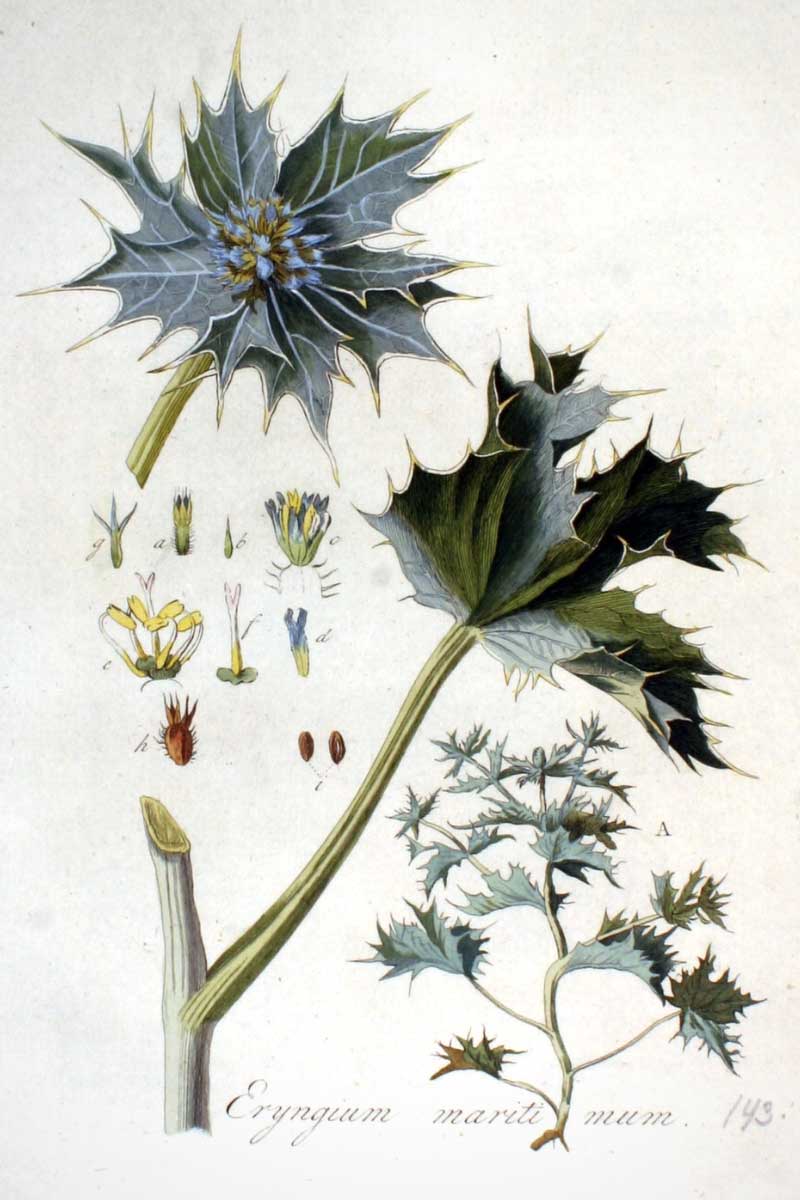
Eryngium maritimum: botanical illustration
Eryngiums do not resemble other Apiaceae, but appear physically closer to thistles (which explains why they are often called “blue thistle”), so at first glance one might think they belong to family Asteraceae (like daisies or dandelions). Their flowering looks more like a dense head than an umbel. Eryngium also resembles Echinops, though the latter belongs to Asteraceae.
Name Panicaut comes from Latin pane cardus: “thistle bread”, due to its resemblance to thistle and its edible character. Young leaves of Eryngium campestre are edible, as are its roots after cooking. In English, Eryngiums are called Sea holly (reference to holly due to spiny foliage).
In Latin, specific names of some Eryngium describe their leaves. Thus Eryngium agavifolium means “with agave-like leaves” (also called Eryngium bromelifolium: bromeliad-like leaves), Eryngium yuccifolium: “with yucca-like leaves”, Eryngium pandanifolium: “with Pandanus-like leaves” (tropical plant resembling a palm). These names refer to exotic, warm-climate plants.
Eryngiums can be divided into two groups:
- European species, mainly hardy and deciduous.
- Species native to South and Central America, which generally form persistent rosettes and are not very hardy. Examples: Eryngium pandanifolium, Eryngium eburneum, Eryngium agavifolium…
South American species are also the most striking. They are among the largest and form very attractive clumps of leaves.
Size of Eryngiums is quite variable, from 15 cm to 1.50 m in height… or even up to 4 m for Eryngium pandanifolium. Some dwarf varieties exist, such as Eryngium ‘Tiny Jackpot’, which does not exceed 35 cm! Small Eryngiums (e.g. Eryngium bourgatii, E. variifolium, E. maritimum…) should be placed at front of borders, while larger ones (E. pandanifolium, E. agavifolium, E. yuccifolium, E. giganteum…) can form background planting. They may require staking to keep stems upright.
Eryngiums generally have very branched habit! Upright stems divide in an almost geometric, regular way… and each branching ends with an inflorescence. Eryngiums can take different shapes. Eryngium tripartitum has a messy appearance, branches going every which way! It produces a multitude of small inflorescences on numerous branches, giving a vapoury effect. By contrast, Eryngium yuccifolium bears small white globes at the ends of tall, straight stems, creating a graphic, elegant effect.
Eryngiums flower in summer. Depending on variety, flowering occurs between July and October. They remain decorative after flowering when carrying seeds.
Inflorescences are dense and compact, unlike most Apiaceae (which form airy, wide umbels). As with Astrances, Eryngiums have their umbels condensed into a domed head. Each head comprises a large number of small flowers. Eryngium inflorescences are very original, quite unique, with a dry appearance.
Flowers of Eryngiums gathered in heads are very small. They consist of five petals and five sepals, together with five stamens and two styles. Looking closely, stamens are longer than petals. Numerous threads, or bristles, protrude around edge of the inflorescence.
Base of the head is surrounded by a collar of very developed spiny bracts, giving the inflorescence a striking star shape. Bracts vary by variety. Bracts are thin and acute, sharp-pointed in Eryngium variifolium! Combined with its strongly spiny foliage, this species must be very effective at deterring herbivores.
Bracts really enhance the flowering, making it rather majestic. However, in species with smaller bracts, such as Eryngium yuccifolium, flowers are also very decorative, inflorescences appearing more rounded, adding a graphic, regular, almost geometric aspect. When bracts are less developed, rounded appearance of heads stands out more.
When in bloom, Eryngium tripartitum bears countless small bluish globular heads. Given each contains a very large number of tiny flowers… one can only imagine total flower count on a single plant of this species! Its flowering appears disorderly, a profusion of stars merging into a mist.
Inflorescences of Eryngiums are generally silvery-blue. Eryngium amethystinum owes its name to its lovely amethyst hue! Flowers are silvery-white in Eryngium eburneum, E. giganteum, E. yuccifolium… They are greenish and poorly coloured in Eryngium agavifolium.
You can cut inflorescences for use in fresh or dried bouquets.
Eryngiums are good melliferous plants, appreciated by insects, especially butterflies and bees. Each small flower contains nectar, which insects seek while distributing pollen in return.

Flowering of Eryngium alpinum (photo Heinz Staudacher), Eryngium giganteum (photo Anntin), Eryngium maritimum (photo Svdmolen) and Eryngium serra
Besides original flowering, Eryngium foliage is also highly ornamental. Leaves are generally spiny, protecting plants from herbivores. But Eryngiums can also have well-developed basal leaves that are rounded, green and soft, non-spiny.
Depending on species and varieties, leaves can take very different forms. They may be deeply divided or rounded and entire. Sometimes leaves are long and narrow, as in Eryngium pandanifolium, unfolding from an elegant basal rosette.
Eryngiums have basal leaves in a rosette and cauline leaves on stems. Cauline leaves may be alternate, placed one after another, or opposite (inserted in pairs).
Leaf length varies greatly. In some species (notably European), leaves measure less than 10 cm, but can reach up to one metre in others. Leaves of South American species are most impressive, sometimes forming majestic basal rosettes.
Eryngiums offer great diversity not only in leaf shape but also in colour: green, silvery, yellow, bluish, marbled white… Variegated foliage exists, such as variety Eryngium planum ‘Jade Frost’! In Eryngium variifolium, leaves bear very marked white veins, creating a marbled effect. Eryngium ‘Neptune’s Gold’ has strikingly bright yellow foliage, offering a strong contrast with blue flowers.
Rarer in cultivation, Eryngium venustum is exceptional for its finely and regularly divided foliage, pointed. Each leaf seems to bear teeth around a central midrib. A rare and very original foliage!

Foliage of Eryngium agavifolium (photo Haplochromis), Eryngium maritimum (photo Uleli), Eryngium planum ‘Neptune’s Gold’ and Eryngium bourgatii
Generally, Eryngiums have a long taproot. This helps them resist drought (they seek water deep in soil), but makes transplanting more difficult and increases sensitivity to moulds (roots may rot with excess moisture)…
After flowering, in autumn Eryngium produces fruits and seeds. Fruit is a diachene, formed of two achenes (dry fruits that do not open at ripeness, each containing a single seed). Plant remains decorative when in fruit, retaining characteristic form; metallic-blue inflorescences are simply replaced by brown, dry and graphic seedheads.
In Eryngium campestre, seedheads have the particularity of detaching when ripe and rolling along ground, carried by wind, allowing seed dispersal. This is why this species is sometimes called “rolling thistle” (which, by deformation, gave its common name “Chardon Roland”).
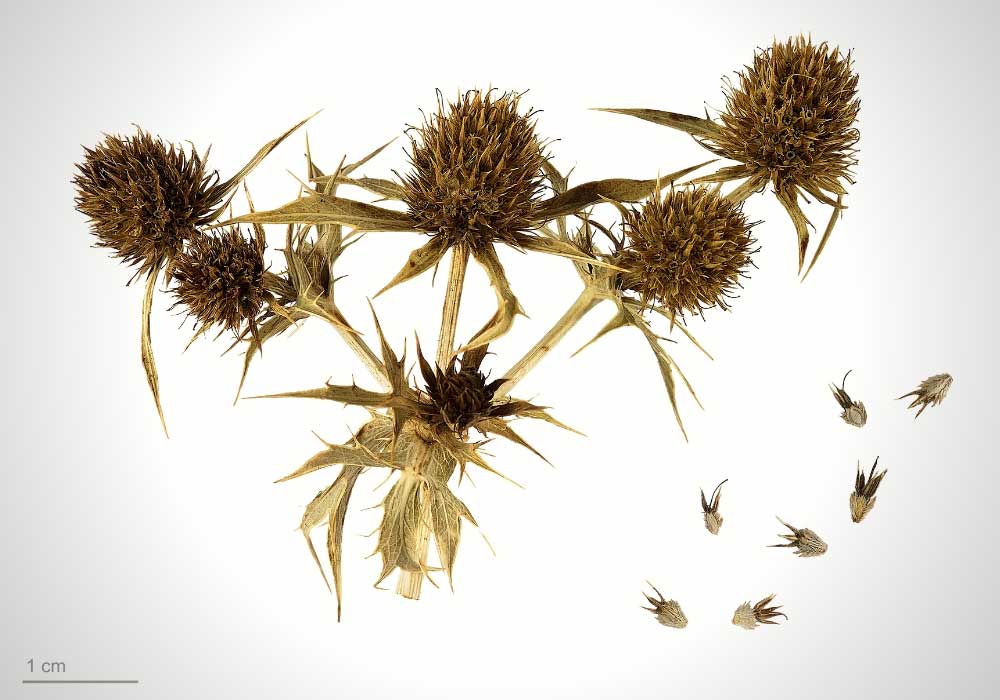
Fruits and seeds of Eryngium campestre (photo Roger Culos – Museum of Toulouse)
Read also
Echinops: planting, growing and careMain species and varieties
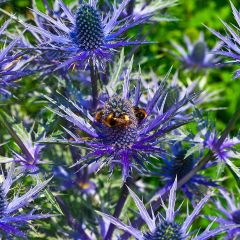
Eryngium alpinum Blue Star
- Flowering time July, August
- Height at maturity 65 cm
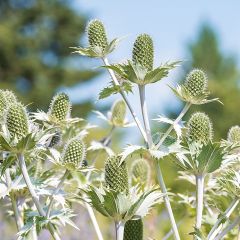
Eryngium giganteum
- Flowering time August to October
- Height at maturity 80 cm
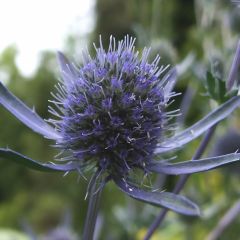
Eryngium planum
- Flowering time July to September
- Height at maturity 80 cm
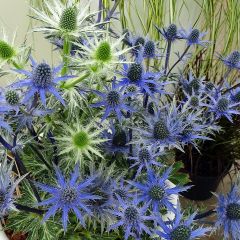
Eryngium zabelii Big Blue
- Flowering time August to November
- Height at maturity 70 cm
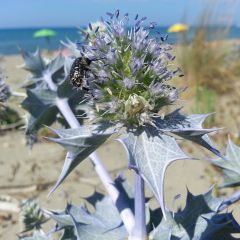
Eryngium maritimum
- Flowering time July to October
- Height at maturity 60 cm
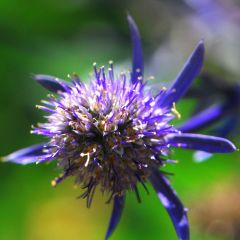
Eryngium planum Jade Frost
- Flowering time August to October
- Height at maturity 60 cm
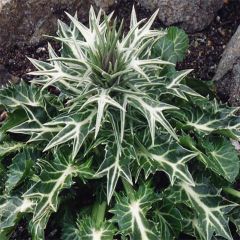
Eryngium variifolium
- Flowering time July to September
- Height at maturity 40 cm
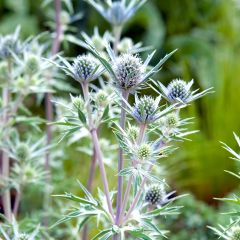
Eryngium bourgatii
- Flowering time August, September
- Height at maturity 40 cm
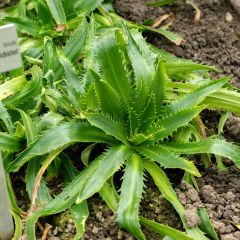
Eryngium agavifolium
- Flowering time August, September
- Height at maturity 1,20 m
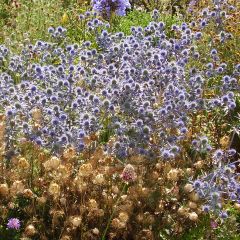
Eryngium tripartitum
- Flowering time August to October
- Height at maturity 70 cm
Discover other Eryngium - Eryngo
View all →Available in 1 sizes
Available in 2 sizes
Available in 2 sizes
Available in 1 sizes
Available in 2 sizes
Available in 1 sizes
Available in 1 sizes
Available in 1 sizes
Available in 1 sizes
Available in 2 sizes
Planting
Where to plant?
Plant Eryngiums in full sun! They will benefit from a warm, well-lit position. In sun their colours are brighter and more pronounced, flowering more abundant, and their habit more robust, compact and sturdy. In shade, Eryngiums become leggier and softer, and may need staking.
It is important to plant them in well-drained, even stony soil. You can certainly place them in a rockery or in a very mineral garden. Eryngiums prefer sandy, free-draining, rather poor soils. We recommend improving drainage by adding coarse sand or gravel. Don’t hesitate to raise the planting area by creating a mound: water must be able to drain and not stagnate. Eryngium tolerates drought well but dislikes waterlogged conditions in winter.
As Eryngium tolerates sea spray well, you can plant it in a seaside garden. The species best suited to this situation is obviously Eryngium maritimum, which grows naturally on the French coast!
When siting Eryngiums, bear in mind their ultimate size. Eryngium maritimum, E. bourgatii and E. variifolium are small and should be planted towards the front of borders, while larger Eryngium giganteum, E. pandanifolium and E. agavifolium make a fine backdrop when planted behind lower flowers.
Because of their long taproot, Eryngiums do not like being moved. It is therefore best to plant them directly in their final position.
When to plant?
You can plant Eryngium in autumn, around October, or in early spring.
How to plant?
We recommend leaving about 50 cm between plants if you are growing medium-sized Eryngiums, such as Eryngium planum. For larger varieties, allow a greater planting distance.
- Dig a planting hole. Feel free to add coarse sand or gravel, or create a mound to raise the bed so that water can drain away readily.
- Remove Eryngium from its pot and plant it.
- Backfill with the growing medium around it, then firm down lightly.
- Water.
Watch young plants and continue to water them if necessary. Once established, they will be fairly drought-tolerant and will no longer need watering.
You can also grow Eryngiums in pots. Choose a fairly deep container (because of the taproot, which tends to penetrate deeply into the soil). Place a drainage layer at the bottom, then use potting compost mixed with coarse sand. Plant your Eryngium, backfill the growing medium around it, then water. There is no need to add fertiliser. However, place the pot in a sunny spot.
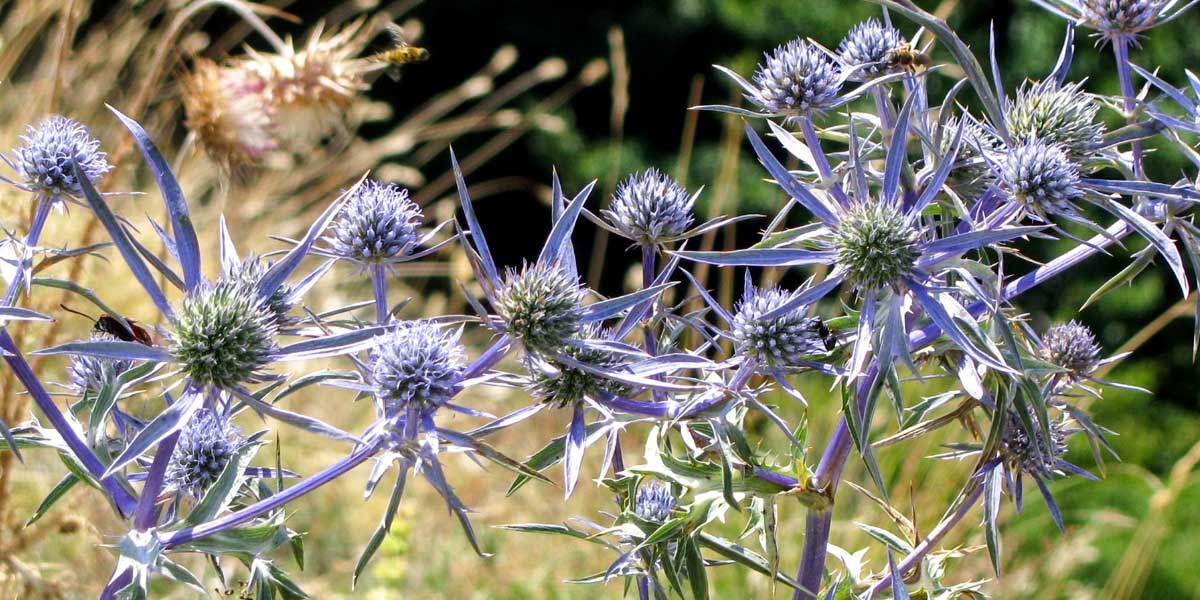
Eryngium amethystinum
Read also
Cirse : planting, growing, careCaring for sea holly
Eryngiums do not really require maintenance. As they grow very well in poor, infertile soils, there is no need to give them compost or fertiliser. Moreover, except for the weeks following planting, there is generally no need to water them. These plants have the advantage of being fairly drought-tolerant! On the contrary, not fertilising or overwatering Eryngiums will help them keep a compact, stocky habit.
If you grow the taller species, if the soil is fertile and cool, or if they are exposed to wind, Eryngiums can have a tendency to flop or collapse. Consider staking them to keep them upright.
Removing faded flowers encourages the plant to prolong its flowering. However, you can also choose to leave them in place, as faded flowers remain decorative in autumn and winter.
You can also harvest the flower stems to use in bouquets, fresh or dried.
Main cultivation problems with Eryngiums are caused by overly wet conditions, which rot the root system or lead to fungal diseases, such as powdery mildew or downy mildew. If these diseases appear, you can treat with a fungicide, for example a sulphur-based solution or a horsetail decoction. It is also important to grow Eryngiums in well-draining soil and to avoid excess moisture.
Slugs sometimes nibble young plants when they are still tender. You can use a slug bait such as Ferramol, or place a ring of sawdust or sand around them to create a physical barrier that will keep slugs and snails away.
Multiplication
Sea hollies are mainly propagated by sowing. Division is complicated because of their long taproot. But it is also possible to propagate eryngium roots in late winter or early spring.
Sowing
Sowing allows multiplication of most species. It is best to stratify seeds by placing them in the refrigerator for about a month before sowing.
- Prepare a pot by filling it with a draining substrate (for example a mix of compost and sand).
- Scatter seeds on the surface.
- Cover them with a thin layer of substrate or vermiculite.
- Water with a fine spray.
- Place your sowing in a bright spot, out of direct sunlight.
Watch out for slugs that like to nibble young plants.
Remember to water occasionally so substrate remains relatively moist, and transplant seedlings when they reach a size that allows handling. Young seedlings can be easily transplanted because their roots are still poorly developed. Transplanting becomes more difficult for mature specimens.
It is also possible to sow seeds directly outdoors in autumn or spring.
Companion planting with Eryngium in the garden
You can use Eryngiums to design a low‑maintenance garden where you will not need to water, add fertiliser or compost, etc. Take the opportunity, for example, to create a mineral‑dominant garden, a scree garden. Choose a warm, sunny spot, create a raised bed, place large stones and a free‑draining substrate. Plant Eryngiums alongside other plants that tolerate drought. Favour cushion or tapetum plants (sedums, phlox, houseleeks, Cerastium…), those with silver foliage or fleshy leaves. Plant agaves, cacti, opuntias and Carpobrotus.
As Eryngium tolerates sea spray well, you can plant it in a seaside garden. Choose Eryngium maritimum, which occurs naturally on the French coast. It will charm with its silvery, rigid and spiny foliage, very graphic. Pair it with Armeria maritima, cistus, Helichrysum, santolinas, Senecio cineraria, and the small grass Lagurus ovatus.
You can create a superb dry garden in full sun by planting Verbascum ‘Polarsommer’, with its woolly foliage and vertical yellow flower spikes, paired with Eryngium oliverianum and a few Centranthus. Add several clumps of Salvia nemorosa ‘Caradonna’ and Stipa tenuifolia to the bed to bring a natural, airy effect! You will obtain an original border that requires very little maintenance. The silvery tones of Verbascum and Eryngium pair wonderfully.
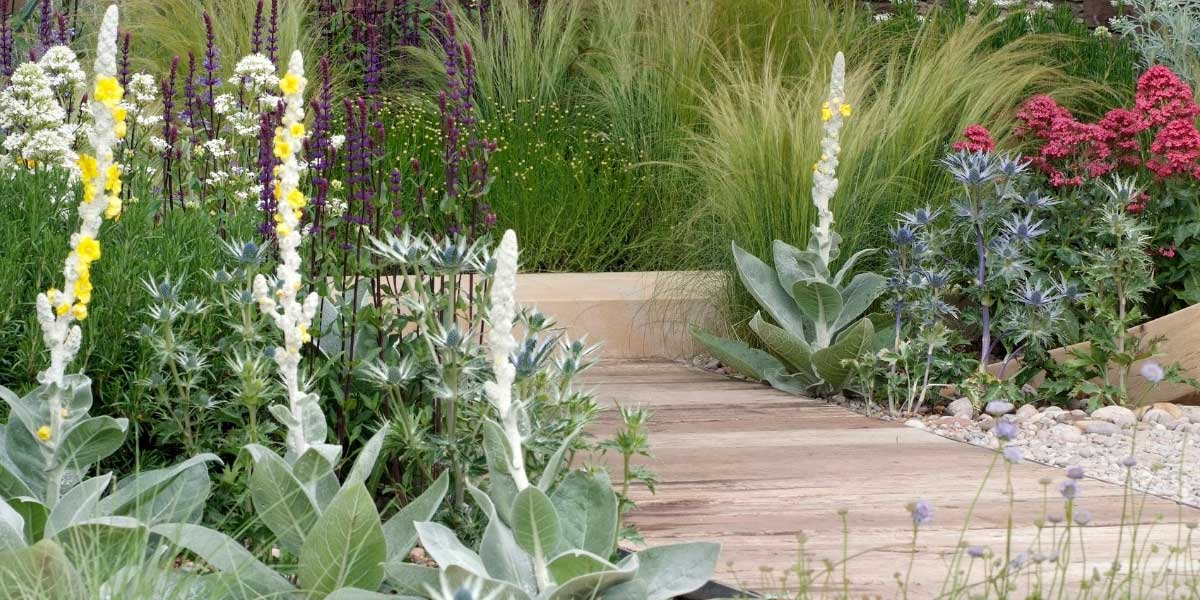
An idea for a dry, sunny garden combination: Verbascum ‘Polarsommer’, Eryngium oliverianum, Centranthus, Salvia nemorosa ‘Caradonna’, Stipa tenuifolia (Landscape designer Robert Myers / Photo AC Nathalie Pasquel – MAP)
You can also integrate Eryngiums into a very natural‑style garden, pairing them with verbena Verbena bonariensis and sage ‘Mystic Spires’. You will obtain a border with a wild, informal, country feel. Add grasses (Stipa, Pennisetum…). You can also include Knautia macedonica, with its lovely light reddish‑purple flowers. Also make use of achillea, for example the variety ‘Terracotta’.
You can also create an alpine garden, using plants that occur naturally in mountainous regions. Soil must be free‑draining, rocky, and ideally sunny. Choose the Alpine sea holly, Eryngium alpinum, and plant gentians, edelweiss, saxifrages, androsaces alongside. Favour tapetum plants and those with a cushion habit.
Finally, because they are very graphic, Eryngiums can be used in modern or contemporary gardens. Pair them with grasses, Echinops, Gaura, Veronicastrum, Eremurus, Perovskia, Verbascum…
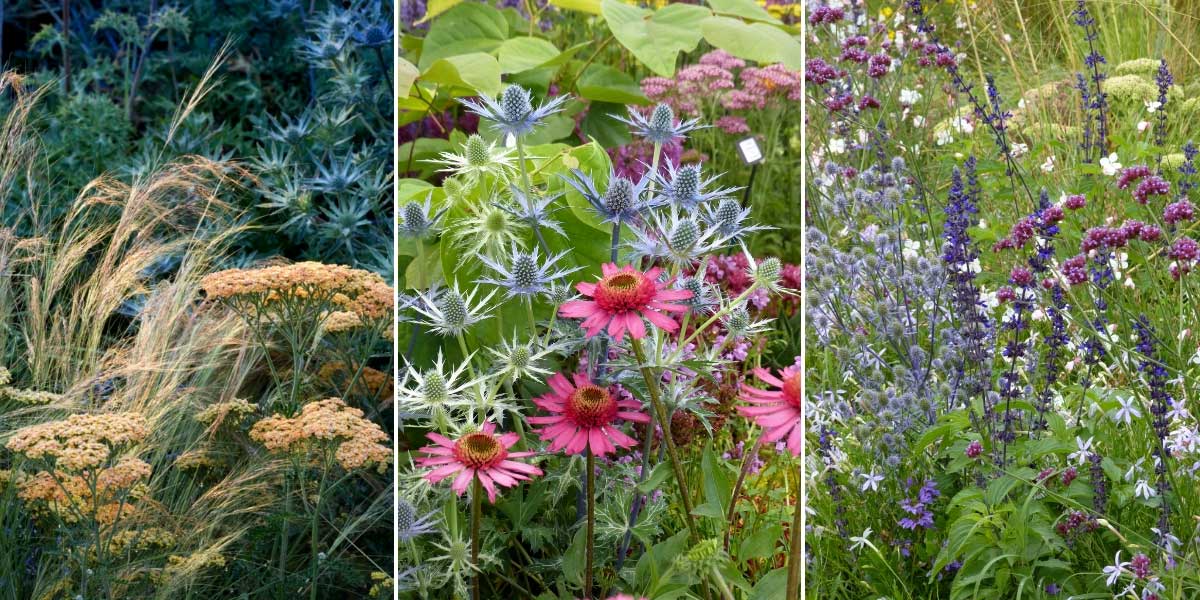
You can include Eryngium in a naturalistic garden! Achillea ‘Terracotta’ and Eryngium oliverianum (photo Clive Nichols – MAP) / Echinacea ‘Delicious Candy’ and Eryngium ‘Picos Blue’ / Verbena bonariensis, Eryngium and Salvia ‘Mystic Spires’
→ Discover other combinations with Eryngium in our care sheet, and in our inspiration Create a trendy bed “thistle and company”
Did you know?
- King oyster mushroom
It sometimes happens that a fungus, the king oyster mushroom (Pleurotus eryngii), shoots from the roots of Eryngium maritimum and Eryngium campestre. It is an excellent edible mushroom, which is sometimes cultivated (kits for growing them are even sold commercially)!
Useful resources
- Discover our range of Eryngiums
- An article by Pierre – Mediterranean plants: where do they really come from?
- An article by Ingrid – Flower bed: vary and mix shapes!
- Our selection of perennials for rockeries
- Our selection of plants for dry gardens
- Ideas and inspiration for a dry garden
- Our article: Choosing an Eryngium
- Ingrid’s tutorial: How to dry blue thistle flowers?
- Subscribe!
- Contents
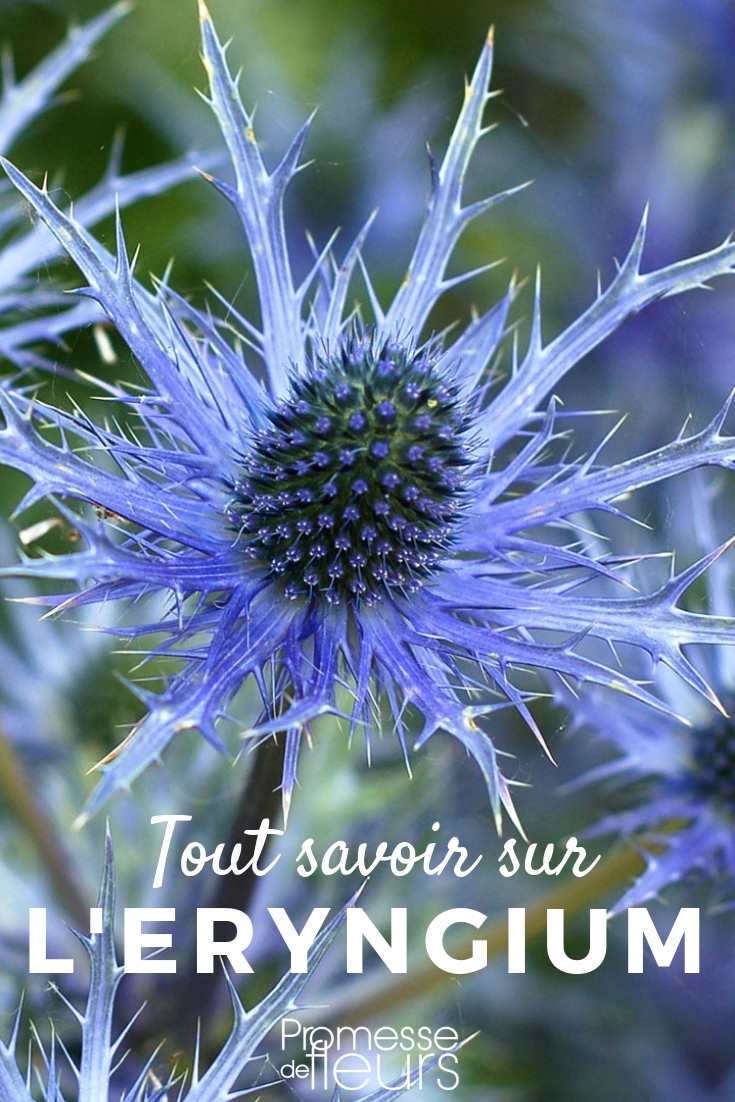

































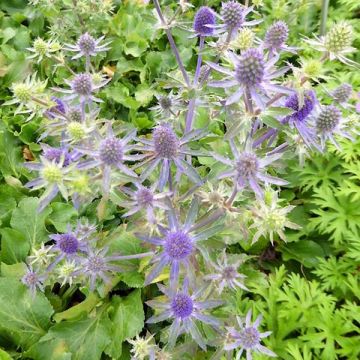
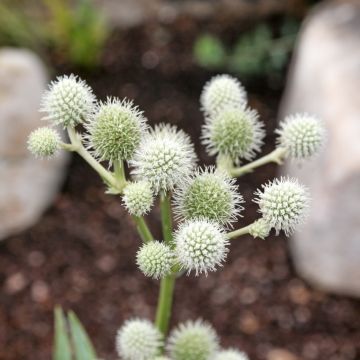


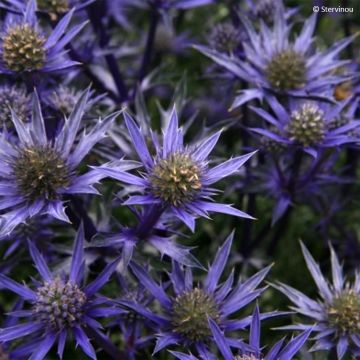



Comments